As promised earlier, here is one of our articles delving into the more advanced side of Fire Emblem Heroes.
For a novice tactician to graduate into something far grander, they must understand and take full advantage of their Heroes’ special abilities: Skills. As the battles get harsher and the stakes higher, this knowledge–in combination with a unrivaled band of Heroes–will eventually become vital to grasping victory from the clutches of defeat.
What are Skills?
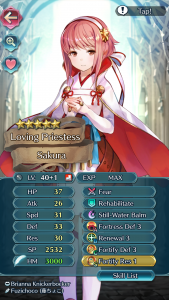
Skills can improve an already strong Hero or make them more viable to use.
Located to the right of the Hero’s status screen, after their stats, Skills are abilities that Heroes may possess or have the capability to learn. They are divided into 6 categories: weapon, support, special, A, B and C. There’s also a “7th” skill, which is the Hero’s Sacred Seal. Although technically not a skill, it basically functions like one, so we’ll include it in our discussion.
As mentioned, some Heroes may have Skills as soon as you get them. The higher the rarity, the more and better skills the Hero will have at the start. Heroes may also have unlearned skills. As Heroes fight, they will earn SP (Skill Points) in addition to experience. Accumulated SP can then be used to learn Skills by going to the Allies – Learn Skills menu.
By default, the Skills available to a Hero depend on the Hero themselves. For example, all Chroms will have access to the Falchion skill. The better the skill, the more SP required to learn it. Very often, some skills require other skills to be learned. Eg. you need to learn Atk +1 before you can learn Atk +2, then you need Atk +2 for Atk +3.
Similarly, you may need to upgrade your Hero to a specific star rarity before they can learn a skill (in Chrom’s case, he needs to be 5-star to learn Falchion, Aether and Spur Def 3). Even after learning all of a Hero’s available skills, there will be unused skill slots. This is where Skill Inheritance comes in–by sacrificing a Hero, you can pass on (almost) any of their skills to another Hero (with a few rules, of course).
Anyway, let’s move onto the categories of skills.
Weapons
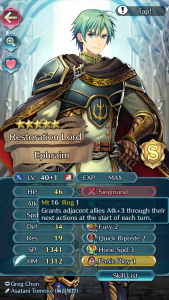
Ephraim’s Siegmund is strong and can buff his allies too.
First off, each Hero typically has a Weapon skill, which represents the weapon they fight with. In other words, a weapon skill is required for a Hero to attack. In most cases, you will want to select a weapon with the highest Mt (Might) stat, as that will directly increase the damage dealt by your Hero (1 more Mt equals 1 more damage).
That said, like in other Fire Emblem games or RPGs in general, some weapons may have comparably lower Might, but provide interesting bonus effects. For example, the Killing Edge is weaker than the Silver Sword, despite being of the same “tier”, but it makes it easier to charge the Hero’s Special gauge (discussed further on), which can potentially lead to a better result.
Some Hero may even have “legendary” or exclusive weapons that set them apart from others. If the weapon has a really fancy name like “Durandal” or “Ragnell” and a cool-sounding bonus effect, it’s probably one such weapon. If so, that Hero is pretty much sorted for life. Even still, feel free to experiment to best fit your playing style.
Support
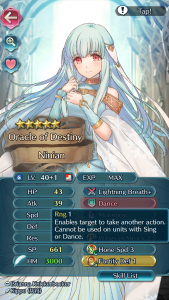
Dance and Sing allows Heroes to take an additional turn during battle.
Below the Weapon skill is the Support skill. Skills of this category–as the name suggests–provide supportive effects for other allies in your team. This can include restoring health, providing a temporary stat boost or even re-positioning an ally. Support skills can be used by targeting an applicable ally–and after using one, the Hero using the skill immediately ends their turn, just like attacking.
Although not quite as thrilling as attacking an opponent, sometimes opting to support an ally can be a very important choice during a difficult battle. An obvious example: if an ally is low health, if you heal them, they can stay in the battle for longer. Less obviously, an ally may be in a dangerous position, but you can use a re-positioning skill like Draw Back to get them out of harm’s way.
Sing and Dance–two skills we recommended in the Top 5 Tips for Beginners–are also both Support skills. Healers will obviously be running a healing Support skill, but if possible, you should outfit all your units with Support skills, because you never know when they may come in handy. If in doubt, go for the re-positioning skills, as they are very multi-purpose.
Special
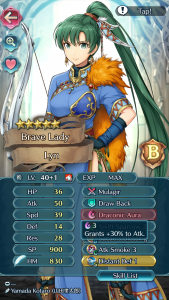
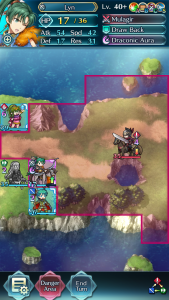
Dealing extra damage is always nice.
After Support skills, we have the fancy-sounding Special skills. These are powerful abilities that can trigger during a fight (or on the map). Generally, if a Hero has a Special skill equipped, a cooldown counter will appear just below their weapon/colour icon on their map sprite. This number can be as high as 6; each time the unit deals damage, heals or receives damage, the counter reduces by 1.
Once the counter reaches 0, it will change to the special icon and on the Hero’s next attack (or heal), the Hero will automatically trigger their Special. Examples of Specials include Luna, which ignores half the foe’s Defence or Resistance stat, or Sol, which restores HP equal to half the damage inflicted to the foe.
Due to the way the cooldown counter works, if you’re smart, you can plan when to unleash your Special by choosing the number of fights your Hero participates in. Needless to say, there are essentially no disadvantages to equipping a Special, so go nuts. Moonbow, which ignores 30% of the enemy’s Defence/Resistance with a short cooldown, is a universally good skill to have.
Passives
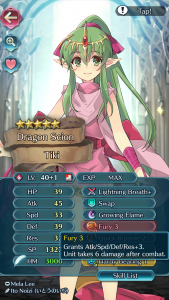
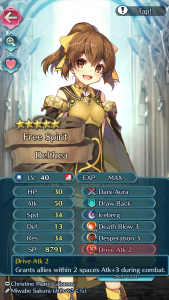
Passive skills can enhance your Heroes or their allies.
Moving on, we have the A, B and C skills. These are all passive skills, which provide a large variety of additional effects, either all the time or depending on the conditions. Like Support skills, while they may not sound too exciting, they can easily make the difference between a victory and a loss, so try not to sleep on them.
A-type skills are usually related to stats. For example, HP +3, HP +4, HP +5. These can be useful for patching up weaknesses or boosting strengths. A universally good A skill is Fury (1/2/3), which provides a small boost to all stats, but at the cost of a small amount of HP after battle. While the HP loss can be painful at first, the boost in stats can improve a lot of match ups and you can always heal afterwards. Also, the HP loss cannot directly cause a KO.
B-type skills are a bit harder to group; they include movement-based skills, battle priority skills and skills that reduce a foe’s stats after battle (and that’s not even all of them). Of the lot, the priority skills are probably the most valuable. Vantage (1/2/3) lets your Hero attack first when under a specific HP threshold, even when attacked. Desperation (1/2/3) delays the foe’s counter-attack(s) until after your Hero has finished attacking.
C-type skills are mostly stat boosts for other allies. They are essentially passive versions of the stat-boosting Support skills. They are useful since you don’t need to waste a turn to use a Support skill, but the catch is that your units must be in the correct range when your turn begins for the C skill to trigger. Eg. Hone Atk (1/2/3) requires the allies to be adjacent to the Hero with the skill to receive the Attack boost.
Sacred Seals
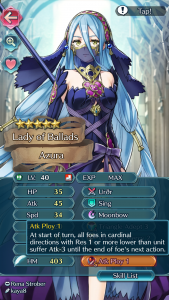
Sacred Seals are wildcards that can potentially tip the scales.
These are basically “skills” that you can freely swap around between Heroes, at no cost. They can be earned by completing quests, Tempest Trials, Chain Challenges, etc. To equip seals, you must go to the Allies – Equip Seals menu. For the most part, Sacred Seals are reskins of passive (A/B/C) skills.
However, because Sacred Seals can be easily swapped around, they are naturally a lot more flexible to use compared to normal skills. Say one of your Heroes is 1 damage shy of defeating a tricky foe, you could give them the Atk +1 seal. But if another Hero suddenly needs that same seal, you can go back and swap.
Aside from this, there are some rather unique seals, most notably the ones obtained from the Tempest Trials. These can often provide metagame-changing effects that don’t even exist as regular skills. For example Hardy Bearing ignores all attack priority changes when your Hero has full HP, perfect for bypassing the enemy’s Vantage or Desperation.
Skill Inheritance
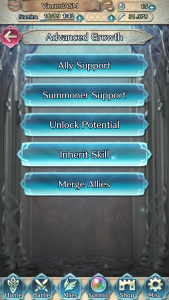
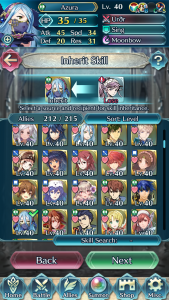
Heroes can inherit skills by “eating” (not literally) another Hero.
Now that we’re hopefully all aware of the different type of skills available to use, it’s time to open Pandora’s Box… At some point down the line, once you’ve leveled up all your favourite Heroes and learned all of their skills, when you think you’ve reached the limits of their potential, there’s still a lot, lot more you can do.
As we inferred near the beginning, via Skill Inheritance, it is possible for Heroes to learn pretty much any Skill. This means you can have nearly any combination of weapon, support, special, A, B and C skills. Thought Takumi was already deadly with Close Counter? You can make him even stronger by inheriting Vantage so he strikes first when at low health to both close and long-range foes.
On the flip side, annoyed that Takumi is ruining your day? You can inherit Raudrraven, Blarraven or Gronraven onto a Tome user to gain a triangle advantage against Bows. Then to further add insult to injury, you could inherit Triangle Adept 1-3 to further increase the triangle advantage, reducing Takumi’s Fujin Yumi to a mere pea-shooter. The choices are almost endless.
To get started with inhering skills, you must go to Allies – Advanced Growth – Inherit Skill. From here, you can choose a Hero to inherit a skill (the “Inherit” box to the left) and a Hero that you wish to sacrifice to pass their skills to the first Hero (the “Lose” box to the right). A Hero may pass down up to 3 skills.
These skills can be of any category, so you can pass down weapons, supports, specials and passives. However there are a couple of rules.
- You can only pass down skills that the sacrificed Hero can learn at their current star rarity. So if they are currently 4-stars, you cannot pass down their 5-star skills. Otherwise it’s kind of cheating the system, right?
- Like learning skills, some skills may require earlier skills to be inherited or learned. For instance, you can’t pass down Hone Atk 3 by itself; you also need Hone Atk 2 and by extension Hone Atk 1. The simplest way to do this is by inheriting Hone Atk 1, 2 and 3 all in one go.
- Some skills, most notably legendary and exclusive weapons, cannot be inherited except by the original owner of the skills. Sadly, Ragnell will never be leaving Ike, for example. But if you wanted to, you could pass down a Falchion from a 5-star Chrom to a 4-star Chrom. It’s unlikely you’d do that, but the option is there.
- Even less obviously, some skills can’t be passed down if there’s a weapon-type or movement-type conflict. Eg. Staff-users cannot inherit offensive-based Specials. Long-ranged units cannot inherit Knock Back or Drag Back. Sword-users cannot inherit Lancebreaker. The list is pretty extensive, so we recommend just experimenting to see what works or not.
Finally, after choosing 3 skills to inherit, the Hero passing down those skills will disappear forever. You’ll never see them again, unless you happen to summon them, so be sure to choose wisely. If in doubt, only use duplicate Heroes for Skill Inheritance, unless you really have no use for a particular Hero (or dislike them).
The inherited skills will begin as unlearned skills, meaning your newly-inherited Hero will have to work hard to earn those skills. Extra hard in fact, as inherited skills cost more SP to learn compared to natural skills. Still, the effort is usually worth it, especially if you manage to put together a killer combination of skills.
…And because we’re kind, here’s an example of an easy Skill Inheritance build for you, if it’s your first time.
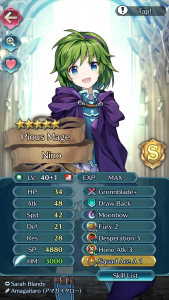
It can take a lot of work to fully deck a Hero out, but the results are worth it!
The Hero: Nino, our lovable 3/4-star Green Mage who can become a monster when upgraded to 5-stars.
- Weapon: Gronnblade+ –Learned naturally at 5-stars. This weapon grants additional damage for each stat boost (highlighted by green numbers) on Nino. With a boost to Attack, Speed, Defence and Resistance, Nino can achieve frightening levels of damage.
- Support: Draw Back –Learned naturally at 3-stars. When used, Nino moves backwards and pulls an ally into the square she moved into. Very useful for dragging an ally out of an enemy’s attack range, especially after they’ve attacked.
- Special: Moonbow –Gotten from Palla or Odin at 4-stars. Gronnblade has the disadvantage of increasing Nino’s Special Cooldown by 1 point. Fortunately Moonbow has one of the shortest cooldowns (2, increased to 3 with Gronnblade) while providing a good damage boost.
- A: Fury 3 –Gotten from Hinata at 4-stars. Boosts Nino’s Attack, Speed, Defence and Resistance by 3 points each, while inflicting 6 damage to Nino after each fight. The HP loss is fairly insignificant since Nino is a glass cannon and shouldn’t be taking damage in the first place. The extra Defence/Resistance can be useful for tanking the first hit as well.
- B: Desperation 3 –Gotten from Shanna at 4-stars. When Nino’s HP drops below 75%, if she can attack twice, her two attacks will go before the enemy’s counter-attack. Nino is pretty speedy, so it’s likely she can attack twice. This skill also has great synergy with Fury. Once her HP drops, she can blow away most foes without fearing a counter-attack.
- C: Hone Atk 3 –Learned naturally at 5-stars. Provides Attack +4 to allies adjacent to Nino at the start of each turn. On top of Nino being a highly destructive force, this helps her party members inflict more damage. Win-win!
(Note: If you don’t have the highest level skills–for instance, we don’t have Fury 3 on our Nino–the lower level ones will suffice until you get them.)
Obviously, that’s just one setup and you’re free to change things around, especially if some of those skills aren’t available to you. Maybe you need a counter for Reinhardt, the meta-defining Blue Tome Cavalier? Consider substituting Fury 3 for Triangle Attack 1-3 so Nino can safely tank his hits and retaliate with a clean KO.
Finally, although we realise we’ve talked quite a lot about skills and inheritance, definitely don’t be put off if it seems like there’s a lot to learn and do. As with most things, you can learn and try things at your own pace. You may not be creating complete builds straight away, but adding just one useful skill to a favourite Hero should be an easy enough starting point, right?